Blue Diamond Discus – Symphysodon aequifasciatus “Blue Diamond” size 4 to, What is a Discus Fish? Discover This Beautiful Species, Ideal for Freshwater Aquariums with Community Friendships
£76.49 Original price was: £76.49.£65.00Current price is: £65.00.
Welcome these beautiful Blue Diamond Discus, known for their stunning coloration and graceful swimming. Ideal for aquarists seeking peaceful community fish, they thrive in freshwater aquariums. Create a vibrant aquatic environment with these elegant companions, perfect for your home.
Species Introduction
The Blue Diamond Discus, scientifically known as Symphysodon aequifasciatus, is a stunning freshwater fish that belongs to the Cichlidae family. This species is native to the Amazon River Basin, where it thrives in slow-moving waters filled with dense vegetation and submerged structures. The Blue Diamond variant is particularly prized for its vibrant blue hue and unique diamond-shaped body, which sets it apart from other discus varieties. These fish can grow to a maximum length of approximately 20 cm and are known for their peaceful nature, making them ideal candidates for community aquariums. Their striking appearance and gentle demeanor create a captivating focal point in any aquatic setup, inviting admiration from both novice and experienced aquarists alike.
Care Requirements Dashboard
| Optimal Living Conditions | |
|---|---|
| Water Temperature | 24-27°C (75-81°F) |
| pH Level | 6.5-7.5 |
| Water Hardness | 4-12 dKH |
| Minimum Tank Size | 80L (20 gal) |
| Salinity | Freshwater |
| Care Level | Beginner Friendly |
Caring for Blue Diamond Discus requires a commitment to maintaining optimal water conditions. A minimum tank size of 200 liters is recommended to provide ample swimming space and to accommodate their social nature. These fish prefer slightly acidic to neutral water, with a pH range of 6.0 to 7.5. The temperature should be kept between 26°C to 30°C (79°F to 86°F), as they thrive in warmer waters typical of their natural habitat. Regular water changes and the use of high-quality filtration systems are essential to ensure a clean environment, which will help prevent diseases and promote overall health.
Natural Behavior & Temperament
The Blue Diamond Discus is known for its calm and gentle temperament, making it a suitable addition to community aquariums. These fish exhibit a social nature, often seen swimming in groups, which is essential for their well-being. In the wild, they inhabit densely vegetated areas where they can find shelter and establish territories. In an aquarium setting, providing hiding spots and open swimming areas will mimic their natural environment and reduce stress. They are relatively peaceful but may exhibit territorial behavior during breeding. Understanding their social dynamics is crucial for creating a harmonious community tank.
Tank Setup Guide
Setting up a suitable environment for Blue Diamond Discus involves careful consideration of tank decor and layout. A well-planted tank with a soft substrate, such as fine gravel or sand, is ideal for these fish. Incorporating live plants, driftwood, and rocks will create a natural biotope that mimics their habitat in the Amazon. Plants like Amazon swords, Java ferns, and Anubias are excellent choices, as they not only enhance the aesthetic appeal but also provide hiding spots and help maintain water quality. Additionally, maintaining a gentle water flow with appropriate filtration will ensure that the discus feel secure and thrive in their new home.
Water Quality Management
Maintaining water quality is paramount for the health of Blue Diamond Discus. Regular testing of water parameters is essential to ensure they remain within the ideal ranges. The pH should be kept between 6.0 and 7.5, with a temperature range of 26°C to 30°C (79°F to 86°F). The hardness of the water should ideally be between 1 to 10 dGH. To maintain these conditions, regular water changes of 25-30% weekly are recommended. Using a high-quality water conditioner can help remove harmful chemicals and improve water quality. Monitoring ammonia, nitrite, and nitrate levels is also crucial, as elevated levels can lead to stress and health issues in discus fish.
Feeding & Nutrition
Feeding Blue Diamond Discus requires a balanced diet to ensure their health and vibrant coloration. These fish are omnivorous, and their diet should consist of high-quality pellets, flakes, and frozen or live foods. A varied diet including brine shrimp, bloodworms, and daphnia will provide essential nutrients and promote optimal growth. It is advisable to feed them small amounts 2-3 times a day, ensuring that all food is consumed within a few minutes to prevent water quality issues. Additionally, providing occasional vegetable matter, such as blanched spinach or spirulina, can enhance their diet and overall health.
Compatibility Guide
When considering tank mates for Blue Diamond Discus, it is crucial to select compatible species to maintain a peaceful community. Ideal tank mates include other peaceful freshwater fish such as tetras, corydoras, and peaceful barbs. Avoid aggressive species that may stress the discus or compete for food. Additionally, it is advisable to keep them in groups of at least six to reduce stress and promote natural behavior. Understanding the social dynamics of the aquarium is essential to ensure a harmonious environment where all fish can thrive together.
Health & Wellness
Maintaining the health and wellness of Blue Diamond Discus involves regular monitoring for signs of illness and stress. Common health issues include ich, fin rot, and internal parasites. Observing their behavior and appearance is crucial; healthy discus are active, with vibrant coloration and clear eyes. Preventative measures include maintaining optimal water quality, providing a balanced diet, and ensuring a stress-free environment. Quarantining new fish before introducing them to the main tank can also help prevent the spread of diseases. Regular health checks and prompt treatment of any issues will contribute to the longevity and vitality of these beautiful fish.
Breeding Information
Breeding Blue Diamond Discus can be a rewarding experience for aquarists. These fish typically reach sexual maturity at around 12 months of age. To encourage breeding, it is important to provide a separate breeding tank with optimal conditions, including slightly warmer water and a flat surface for spawning. The female will lay eggs on the chosen surface, while the male fertilizes them. After hatching, the fry will require specialized care, including infusoria or finely crushed food until they are large enough to eat regular pellets. Monitoring water quality during this time is critical to ensure the health and growth of the fry.
Acclimation Process
Introducing Blue Diamond Discus to a new aquarium requires a careful acclimation process to minimize stress. Begin by floating the sealed bag in the tank for about 15-20 minutes to equalize the temperature. After that, gradually mix small amounts of tank water into the bag over the course of an hour. This slow acclimation helps the fish adjust to the new water conditions. Once acclimated, gently release the discus into the tank without adding the water from the bag. This method reduces the risk of introducing harmful pathogens and ensures a smoother transition for your new aquatic companions.
Long-term Care
Long-term care of Blue Diamond Discus involves a commitment to maintaining their environment and health throughout their lifespan, which can range from 10 to 15 years with proper care. Regular water changes, consistent feeding schedules, and monitoring for signs of stress or illness are essential practices. As they grow, it is important to ensure that the tank size remains suitable for their needs, adjusting as necessary. Providing a stable and enriching environment will contribute to their overall well-being and longevity, allowing you to enjoy their beauty for many years.
Natural Habitat Recreation
Recreating the natural habitat of Blue Diamond Discus in your aquarium is essential for their comfort and health. In the wild, they inhabit slow-moving waters with plenty of vegetation. To mimic this environment, include a variety of live plants, such as Amazon swords and Java ferns, along with driftwood and rocks. The use of soft, sandy substrate can also help replicate their natural surroundings. Additionally, maintaining a gentle water flow and providing shaded areas will help create a tranquil environment that encourages natural behaviors and reduces stress.
Seasonal Care Adjustments
As seasons change, it is important to adjust the care routine for Blue Diamond Discus to ensure their continued health and happiness. During warmer months, monitor water temperature closely to prevent overheating, while in colder months, ensure that the tank is adequately heated to maintain the preferred temperature range. Additionally, changes in lighting duration may be necessary to simulate seasonal variations, promoting natural behaviors and breeding cycles. Regularly observing your discus will help you identify any changes in behavior or health that may require adjustments to their care routine.
Expert Tips
For those looking to provide optimal care for Blue Diamond Discus, consider these expert tips. First, invest in a high-quality filtration system to maintain excellent water quality, as discus are sensitive to changes in their environment. Second, establish a routine for regular water changes and tank maintenance to prevent the buildup of harmful substances. Lastly, be patient and observant; understanding the individual personalities of your discus will help you create a harmonious community tank and enhance your overall experience as an aquarist.
Troubleshooting
Common issues with Blue Diamond Discus can often be traced back to water quality or stress factors. If you notice signs of illness, such as lethargy or changes in appetite, immediately test the water parameters to identify any discrepancies. Additionally, ensure that tank mates are compatible and not causing undue stress. If problems persist, consider consulting with a veterinarian specializing in fish health to address any underlying issues effectively. Prompt action can often prevent minor problems from escalating into serious health concerns.
Scientific Background
The Blue Diamond Discus is a fascinating species with a rich scientific background. Belonging to the genus Symphysodon, they are closely related to other discus varieties, each exhibiting unique colorations and patterns. Research into their natural behaviors and habitats has provided valuable insights into their care requirements in captivity. Conservation efforts are also crucial, as habitat destruction poses a threat to their populations in the wild. Understanding their scientific classification and ecological significance can enhance the appreciation of these beautiful fish and the importance of preserving their natural environments.
Advanced Care Techniques
For experienced aquarists looking to take their care of Blue Diamond Discus to the next level, consider implementing advanced techniques such as breeding conditioning and specialized feeding regimens. Conditioning pairs for breeding may involve adjusting water parameters and providing high-protein foods to enhance reproductive success. Additionally, utilizing advanced filtration methods, such as UV sterilizers, can help maintain optimal water quality and reduce the risk of disease. Engaging in regular research and staying informed about the latest advancements in discus care will further enhance your ability to provide a thriving environment for these magnificent fish.
Water Quality Parameters
Optimal Range
24-27°C
6.5-7.5
0 ppm
Caution Zone
22-24°C or 27-29°C
6.0-6.5 or 7.5-8.0
0.25-0.5 ppm
Danger Zone
<22°C or >29°C
<6.0 or >8.0
>0.5 ppm
Monitoring Tip: Test water parameters weekly and perform regular water changes to maintain optimal conditions for your aquatic friends!
Frequently Asked Questions
Q: What tank size is required for the Blue Diamond Discus?
To provide a comfortable home for your Blue Diamond Discus, it is recommended to have a minimum tank size of 150 litres (approximately 40 gallons). This size allows ample swimming space and helps maintain stable water parameters, which are crucial for their health. Discus are social creatures and thrive in groups, so a larger tank can accommodate multiple fish, enhancing their well-being. Consider adding height to the tank, as Discus enjoy swimming at various levels. Additionally, a well-planted aquarium with hiding spots can help reduce stress and mimic their natural environment.
✓ Expert Tip
Ensure your tank is cycled before introducing Discus, as stable water conditions are vital for their health.
Q: What water parameters do Blue Diamond Discus require?
Blue Diamond Discus thrive in soft, slightly acidic water. Ideally, the pH should be maintained between 6.0 and 7.0, with a hardness of 1-10 dGH. The temperature is equally important; keeping it within the range of 28-30°C (82-86°F) promotes optimal health. Regular water changes, approximately 20-30% weekly, are crucial to maintain water quality and remove toxins. It’s advisable to use a reliable water testing kit to monitor these parameters consistently, ensuring your aquatic companions remain healthy and vibrant.
✓ Expert Tip
Consider using a reverse osmosis (RO) unit to achieve ideal water conditions if your tap water is unsuitable.
Q: How often should I feed my Blue Diamond Discus?
Feeding your Blue Diamond Discus is crucial for their growth and health. It is recommended to feed them 2-3 times a day with a varied diet. High-quality pellets, frozen or live food such as brine shrimp and bloodworms, are excellent options. Ensure the food is appropriately sized and can be consumed within a few minutes to prevent overfeeding, which can lead to water quality issues. Also, consider incorporating spirulina and vegetable-based foods to provide balanced nutrition. Regular feeding schedules help establish a routine, making them feel secure.
✓ Expert Tip
Introduce new foods gradually to avoid digestive issues, and observe their preferences.
Q: What are the best tank mates for Blue Diamond Discus?
When selecting tank mates for your Blue Diamond Discus, opt for peaceful and similar-sized species to avoid aggression and stress. Suitable companions include Tetras, Corydoras, and certain species of Rasboras. Ensure that all fish are compatible with the soft, warm water conditions preferred by Discus. Avoid aggressive species and fin-nippers, as they can cause stress and harm to the Discus. Additionally, it’s best to keep tank mates in groups, which helps create a more balanced and harmonious community in the aquarium.
✓ Expert Tip
Introduce new fish slowly to the tank to minimise territorial disputes and stress.
Q: How do I properly acclimatise Blue Diamond Discus to my aquarium?
Acclimatising your Blue Diamond Discus is essential to ensure their smooth transition into your aquarium. Begin by floating the sealed bag containing the fish in your tank for approximately 15-20 minutes to equalise the temperature. After this, gradually add small amounts of tank water to the bag every 5-10 minutes, allowing the fish to adapt to the new water parameters. This process should take about an hour. Once complete, gently release the fish into the tank using a net to avoid introducing bag water, which may contain harmful substances.
✓ Expert Tip
Avoid placing the fish directly into the tank water from the bag, as this can lead to stress and health issues.
Q: What are the signs of healthy Blue Diamond Discus?
Healthy Blue Diamond Discus exhibit vibrant colours, active swimming behaviour, and an appetite for food. Their fins should be fully extended, and they should not display any signs of distress, such as hiding excessively or staying near the bottom of the tank. Clear eyes and a smooth, unblemished body are also indicators of good health. Regular observation is essential; any sudden changes in behaviour, colour, or eating habits may signal health issues that require attention. Maintaining optimal water conditions significantly contributes to their overall health.
✓ Expert Tip
Regularly check water parameters and perform maintenance to prevent health issues.
Q: How do I successfully breed Blue Diamond Discus?
Breeding Blue Diamond Discus can be a rewarding experience, requiring specific conditions. A breeding pair should be established in a separate breeding tank, ideally with a flat surface for egg-laying. The water should be slightly warmer (around 30°C or 86°F) and maintained at a pH of 6.0 to 6.5. Provide high-quality food to encourage breeding behaviour. After laying eggs, both parents will guard and care for the fry. It is crucial to maintain excellent water quality during this phase to ensure the fry’s survival. Regular water changes and feeding infusoria or finely crushed food are recommended for the young fish.
✓ Expert Tip
Remove any uneaten food promptly to maintain water quality during breeding.
Q: What temperature should I maintain for Blue Diamond Discus?
Maintaining the correct temperature is vital for the health of your Blue Diamond Discus. They thrive best in temperatures ranging from 28°C to 30°C (82°F to 86°F). A stable temperature is crucial; fluctuations can lead to stress and susceptibility to disease. An aquarium heater with a reliable thermostat is recommended to maintain consistent warmth. Regular monitoring with a quality thermometer will help you ensure your tank remains within the ideal range. Remember to gradually adjust temperatures if changes are necessary to avoid shocking your fish.
✓ Expert Tip
Use a heater guard to prevent accidental burns, especially if your Discus are particularly active.
Q: How long do Blue Diamond Discus typically live in captivity?
With proper care, Blue Diamond Discus can live for 10 to 15 years in captivity. Their longevity greatly depends on the quality of care they receive, including optimal water conditions, a balanced diet, and a stress-free environment. Regular health checks and prompt treatment of any illnesses can also contribute to a longer lifespan. Establishing a routine for tank maintenance, including water changes and monitoring water parameters, is essential to support their well-being throughout their lives.
✓ Expert Tip
Keep a journal of your Discus’s health and tank conditions to track changes over time.
Q: What type of substrate is most suitable for Blue Diamond Discus?
For Blue Diamond Discus, a soft, sandy substrate is ideal. This type of substrate mimics their natural habitat, allowing them to forage comfortably without risking injury to their delicate bodies. Sand also facilitates the growth of beneficial bacteria, which can aid in maintaining water quality. It is advisable to avoid sharp or rough substrates, as these can cause injuries. Additionally, incorporating plants and decorations can create hiding spots and enhance their environment, making them feel secure and reducing stress.
✓ Expert Tip
Regularly clean the substrate to prevent the build-up of waste and maintain water quality.
Q: What behavioural patterns should I expect from Blue Diamond Discus?
Blue Diamond Discus are known for their gentle and social nature. They tend to swim gracefully and prefer to stay in groups, exhibiting schooling behaviour. You may observe them establishing a hierarchy within their group, which is essential for their social dynamics. They can be shy at first and may hide until they feel secure in their environment. Regular interaction and a well-structured habitat will encourage them to display their vibrant colours and active behaviours. Providing ample space and hiding spots will help reduce stress and promote a serene atmosphere.
✓ Expert Tip
Observe their behaviour daily to spot any changes that may indicate stress or health issues.
Q: How can I prevent common diseases in Blue Diamond Discus?
Preventing diseases in Blue Diamond Discus involves maintaining excellent water quality and a stable environment. Regular water changes, monitoring parameters, and providing a balanced diet are essential practices. Quarantine any new fish before introducing them to your main tank to avoid introducing pathogens. Be vigilant for signs of stress or illness, such as changes in eating habits or behaviour. Keeping the tank clean and avoiding overfeeding will help reduce the risk of diseases such as ich or fin rot. Additionally, consider using high-quality medications proactively if necessary.
✓ Expert Tip
Establish a routine for tank maintenance and health checks to catch any issues early.
Q: What lighting conditions do Blue Diamond Discus prefer?
Blue Diamond Discus thrive under moderate lighting conditions. Bright lights can cause stress, so it is advisable to use a dimmable LED or fluorescent lighting system that mimics natural daylight. Providing shaded areas with plants or decorations can help them feel secure. A lighting duration of approximately 10-12 hours a day is optimal, promoting healthy plant growth while allowing the Discus to exhibit their natural behaviour. Regularly monitor the light intensity to ensure it remains comfortable for your fish.
✓ Expert Tip
Utilise a timer to maintain consistent lighting schedules, which can help regulate the Discus’s natural behaviours.
Q: How do I recognise stress in Blue Diamond Discus?
Recognising stress in your Blue Diamond Discus is vital for their well-being. Signs of stress may include hiding excessively, rapid gill movement, or erratic swimming patterns. They may also show a lack of appetite or appear lethargic. Changes in colour, such as dullness or darkening, can also indicate stress. Maintaining stable water parameters, providing adequate hiding spots, and ensuring compatibility with tank mates can help alleviate stress. Regular observation will enable you to identify these signs early, allowing for timely intervention.
✓ Expert Tip
Create a calming environment with plants and decorations to reduce potential stressors.
Q: What natural habitat conditions should I replicate for Blue Diamond Discus?
Replicating the natural habitat of Blue Diamond Discus is essential for their health and behaviour. In the wild, they inhabit slow-moving waters with plenty of vegetation, such as riverbanks and floodplains. To mimic this environment, create a well-planted tank with floating plants and hiding spots. Use a sandy substrate and maintain slightly acidic, soft water. Adding driftwood or rocks can create natural structures, enhancing their sense of security. Regularly monitor and maintain water quality to ensure a healthy ecosystem for your aquatic companions.
✓ Expert Tip
Consider using natural materials to enhance the biotope and reduce stress for your Discus.

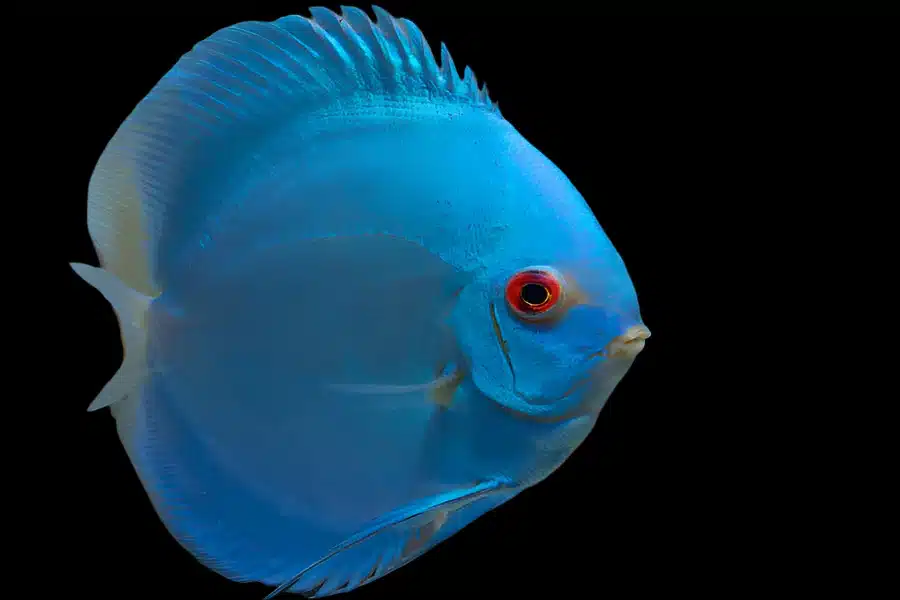
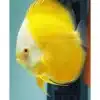
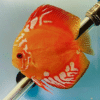

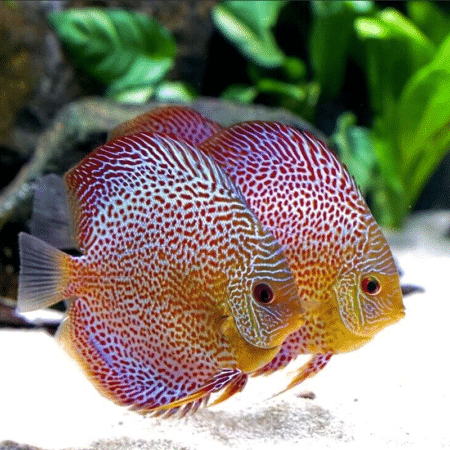
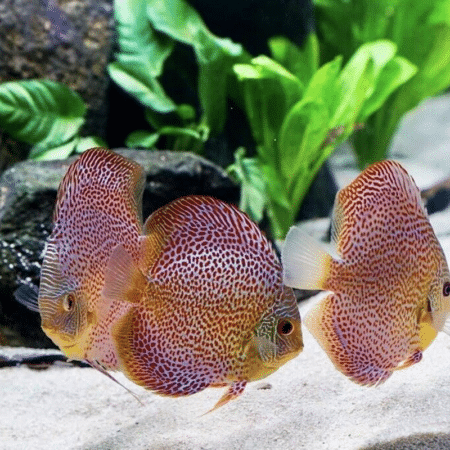
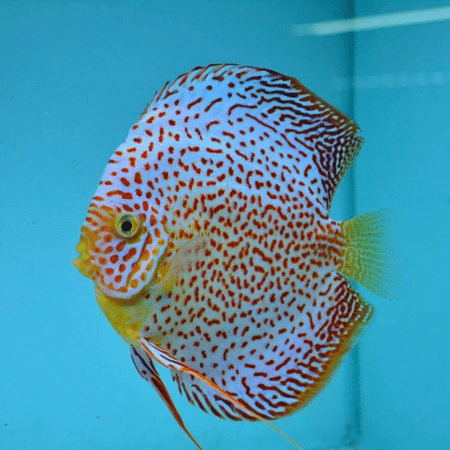




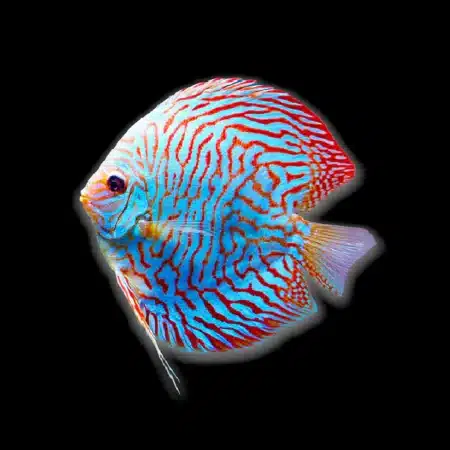
Emily Carter (verified owner) –
I recently added a few Blue Diamond Discus to my aquarium, and I couldn’t be happier with my purchase! These little beauties, measuring about 5 cm, have transformed my tank into a vibrant underwater paradise. Their striking blue coloration and unique patterns are simply mesmerizing to watch. After two weeks in their new home, they’ve acclimated beautifully and are active and healthy, proving their resilience as aquarium fish.
What I love most about these discus is their peaceful nature. They’ve gotten along well with my other fish, creating a harmonious environment. Compared to other discus I’ve had in the past, the Blue Diamond seems to adapt quicker and showcase more brilliant colors, especially when they’re comfortable. They thrive in well-maintained water conditions, so I recommend investing in a quality filtration system and keeping an eye on water parameters.
For anyone looking to start or expand their discus collection, I wholeheartedly recommend these stunning fish. They are perfect for both experienced hobbyists and those just getting into the world of discus fish. Just be sure to provide them with plenty of hiding spots and a calm environment. I’m already planning to get a few more! My only minor concern is their sensitivity to sudden changes; just take your time with acclimation, and you’ll be golden.
Emily Carter (verified owner) –
I recently added the Blue Diamond Discus to my freshwater aquarium, and I couldn’t be happier! These beautiful fish have been with me for about two months now, and their vibrant colors and graceful swimming have transformed my tank into a captivating underwater paradise. The size 4 fish I received were healthy, lively, and acclimated quickly to their new environment. I’ve experienced no issues with aggression, as my community tank is home to several peaceful species, and my discus seem to thrive in this harmonious setup. Compared to other discus I’ve kept, the Blue Diamonds are truly special with their striking patterns and calm demeanor. My only minor concern is that they do require slightly warmer water, but that’s just part of the joy of caring for these magnificent aquarium fish. I highly recommend the Blue Diamond Discus to any passionate aquarist, especially those looking to add a touch of elegance to their tanks. If you’re considering them, don’t hesitate – they’re worth every moment of care!